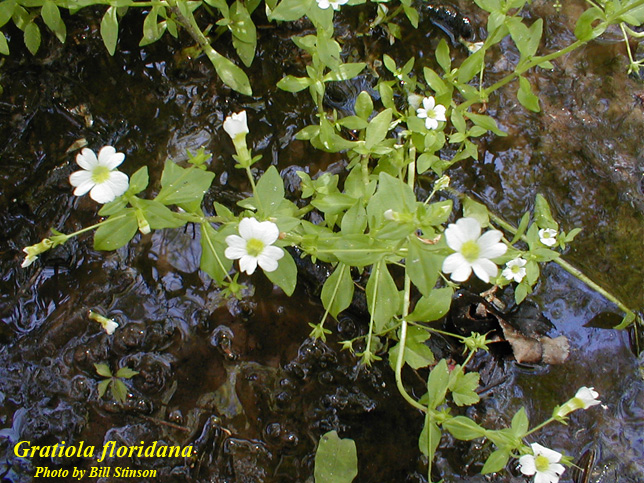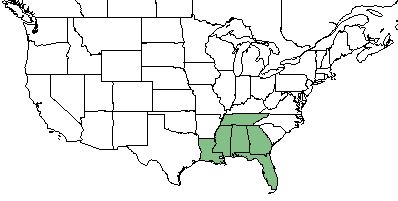Gratiola floridana
Common name: Florida hedgehyssop
| Gratiola floridana | |
|---|---|

| |
| Photo by the Atlas of Florida Plants Database | |
| Scientific classification | |
| Kingdom: | Plantae |
| Division: | Magnoliophyta - Flowering plants |
| Class: | Magnoliopsida - Dicots |
| Order: | Scrophulariales |
| Family: | Scrophulariaceae |
| Genus: | Gratiola |
| Species: | G. floridana |
| Binomial name | |
| Gratiola floridana Nutt. | |

| |
| Natural range of Gratiola floridana from USDA NRCS Plants Database. | |
Contents
[hide]Taxonomic Notes
Synonyms: none.[1]
Varieties: none.[1]
Description
Also known as the Florida hedgehyssop, G. floridana is a native annual forb that is a member of the Scrophulariaceae family.[2] Size class is between 0 to 1 foot with white to pink colored flowers.[3]
Distribution
G. floridana is found in the Southeast United States, ranging from Louisiana and Florida to less frequently found in Tennessee.[2] More specifically, it ranges from northeastern Georgia and southeastern Tennessee south to eastern Georgia, northeastern Florida and the panhandle, Alabama, and Mississippi.[4]
Ecology
Habitat
G. floridana can be found in spring runs, steam banks, and blackwater swamps [4]. It has specifically been seen in shaded wet muck of floodplains, and partially shaded mesic firebreak trails.[5] This species is also listed by the USDA Natural Resources Conservation Service as an obligate wetland species that only occurs in wetland habitats.[2]
Associated species - Ludwigia palustris [5]
Phenology
G. floridana has been observed to flower in March [6], but it has been seen to flower in April and May as well. Fruiting time ranges from March until April. [5]
Fire ecology
Species in the Gratiola genus were found in one study to appear in a community 13 years after a fire disturbance.[7]
Use by animals
Conservation, cultivation, and restoration
It is considered endangered in the state of Tennessee yet not in any other region, but G. floridana should be monitored in the communities for its infrequency.[2] As well, it is listed on the global status as G4 due to its restricted distribution and rarity, and is vulnerable in Georgia, critically imperiled in Tennessee and Mississippi, and possibly extirpated in Louisiana.[8]
Cultural use
Medicinally, species in the Gratiola genus are said to have purgative properties.[9]
Photo Gallery
References and notes
- ↑ Jump up to: 1.0 1.1 Weakley, A.S. 2015. Flora of the southern and mid-atlantic states. Working Draft of 21 May 2015. University of North Carolina at Chapel Hill, Chapel Hill, North Carolina.
- ↑ Jump up to: 2.0 2.1 2.2 2.3 USDA Plants Database URL: https://plants.usda.gov/core/profile?symbol=GRFL2
- Jump up ↑ [[1]] Lady Bird Johnson Wildflower Center. Accessed: May 17, 2019
- ↑ Jump up to: 4.0 4.1 Weakley, A. S. (2015). Flora of the Southern and Mid-Atlantic States. Chapel Hill, NC, University of North Carolina Herbarium.
- ↑ Jump up to: 5.0 5.1 5.2 Florida State University Robert K. Godfrey Herbarium database. URL: http://herbarium.bio.fsu.edu. Last accessed: June 2018. Collectors: Loran C. Anderson, David Roddenberry, Robert K. Godfrey, R. Kral, and J. M. Kane. States and counties: Florida: Gadsden, Wakulla, Jackson, and Leon. Georgia: Thomas. Alabama: Etowah, and Dallas.
- Jump up ↑ Nelson, G. PanFlora: Plant data for the eastern United States with emphasis on the Southeastern Coastal Plains, Florida, and the Florida Panhandle. www.gilnelson.com/PanFlora/ Accessed: 22 MAY 2018
- Jump up ↑ Maliakal, S. K., et al. (2000). "Community composition and regeneration of Lake Wales Ridge wiregrass flatwoods in relation to time-since-fire " The Journal of the Torrey Botanical Society 127(2): 125-138.
- Jump up ↑ [[2]] NatureServe Explorer. Accessed: May 17, 2019
- Jump up ↑ Rafinesque, C. S. (1828). Medical flora; or Manual of the medical botany of the United States of North America.